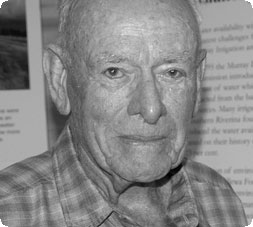 |
 |
|
Adrian DouglasNot long after completing his service with the Australian Infantry Forces during World War 2, Deniliquin born Adrian Douglas joined the Water Conservation and Irrigation Commission as an assistant engineer, working on construction of the irrigation system in southern NSW. INTERVIEW TRANSCRIPTThe following text is based on an edited the transcript of an interview recorded in March 2005, edited for readability and incorporating some corrections to details as requested by the interviewee. Key topics: Construction of the Deniboota and Denimein Irrigation systems, moving draglines to Coleambally Lawson Syphons, working conditions, Federated Engine Drivers strike, draglines, development of Bunaloo Under John Murray, Resident Engineer, Deniboota, I was engineer in charge of channel construction - first of all, Denimein. We built the whole of the Denimein irrigation - all the structures and channels for Denimein Irrigation District and at the same time had the draglines working on the Deniboota canal. When they finished the Deniboota canal, we brought them [the draglines] across the [Edward] river at the Lawson Syphon where we had a bridge which had been built in about 1939. and we brought them across that bridge. The draglines were very heavy, weighed 120 tons each, so needed a fair size bridge to take them across. And then we enlarged the Moulamein channel and constructed that with the draglines. The Moulamein channel is the main supply channel to Denimein. And as we got near the end of the Moulamein channel, the channel was too small for those machines and the draglines were shifted down to Box Creek near Barratta and started excavating the main escape channel for the Denimein and Berriquin districts. The draglines themselves were used up until - they were still building channels and drains until it was decided to move them to Coleambally, and that would be December 1957. I was in charge of the construction of Box Creek escape channel from Barratta up until - I’ve forgotten how far - till nearly Pretty Pine I think, and until I was sent to Glenbawn Dam [on the Hunter River in northern NSW] - as 2IC. at Glenbawn Dam. And then when we had nearly finished Glenbawn Dam three years later, I was sent to to start off Coleambally work. The set-up was - I was sent down with a to pick up a utility at Narrandera and I was given a cheque book and told that the work was to be done from Darlington Point, we were to use Darlington Point as a headquarters and we were to get on with the construction of the Coleambally Canal and the Gogeldrie Weir.” Draglines moved to Coleambally Anyhow, the draglines - I came over to Deniliquin and I borrowed Claude Hubbard. Claude had been my chainman at Deniliquin and was a very, very capable chainman and capable with maps and things, and I got out a big map and drew a line across the map from Blighty to where they were to start the Coleambally Canal and said to Claude, “Go along that line and bring me back details of any - of the - how we go. And so Claude went and found every fence, every road, every power line, every creek, every gully, and he did it very well. And when we the time was given to bring the draglines across, we started them off walking a straight line, walking at 1000 feet per hour, which works out 5000 feet in five hours, which is about a mile every five hours, and we walked them on two 10-hour shifts per day, straight across country, and that’s how they got to Coleambally and started that canal going. The building of channels in those days - the bigger channels were built with our very big equipment. The draglines and big bulldozers we had were big for those days - D8 tractors, and the draglines were quite big too, but the branch channels and smaller channels were built by contractors, mainly with horse teams, but some of the contractors had become quite modern and had tractors. Workers go on strike “The whole time we were building the canal and channels, we got our money fairly directly and we seemed to manage to keep ahead of plans . But there was one time when the draglines were getting down towards Bunnaloo, building the Deniboota Canal and we had agreed that 25 miles transporting men from Deniliquin was as far as we could reasonably take them. We did the arithmetic and it was clear that after 25 miles we should camp the men, and so we prepared a camp at Bunaloo, provided with a batching kitchen. And three weeks before Christmas when we reached this 25 mile magic line Norman Thom, who was resident engineer, directed that the men would go into camp at that stage. And the men said, “We’d prefer not to. We want a cook”. The awards provided for only batching arrangements. Each man had to cook for himself or - they were all paid a camping allowance, and the camping allowance was supposed to be adequate to employ a cook. Anyhow, the men said, “That’s not good enough. We are not going to go there unless we get a cook”. “And Norman Thom said, “Well” - he had no power to give them a cook anyhow. The Irrigation Commission set-up was such that we couldn’t provide them with a cook. But he said, “You’ve got to go now”, and it was three weeks before Christmas. And the men said, “Well, can’t you put it off till after Christmas?” And he said, “No. You’ve got to go now”. The men said, “Well, that’s bad luck. We’re not going”, and so they went on strike. And they were all FED members - Federated Engine Drivers. And the other main union on the job was the AWU, and the AWU were concrete hands and etcetera, and so the structure gangs went ahead with their job, but all the main machines just stopped, and that included the pile driving out at the syphon, and it went on. “At that time men could get a job anywhere, and although they were on strike, I’m sure that all those that needed to just walked around the corner and got a job - it mightn’t have been equivalent pay, but they got a job straight away, and so they were not very anxious about going back. And the Irrigation Commission wasn’t particularly worried. Anyhow, I happened to run into Mr Lawson, member for parliament for this area, and told him what was happening, and a week or so later there was an investigation by a judge and various others, but the judge would only come down provided the men were in camp and operating normally. So, the F.E.D. men went out to the Bunnaloo camp without a cook. The judge and all his associates came and had a look at it all, everything was working happily enough, and away he went, and none of us ever heard any result from that, but the job went on happily. And the men went back to work and the syphon pile driving went ahead again and the dragline operating went on. The working week A week was five days, and while the syphon was being built and the channels were going ahead, there was practically no overtime worked. The only overtime worked was by the mechanics who maintained the draglines and associated machinery, and they did that on weekends, and they were the only ones who worked overtime. But the - each day was a full 8 hours on the job, and most of the work of the Deniboota area was one-shiftwork. The syphon was one shift, for a start, then it went on to two, and there was a period when there were three shifts. The men started, left in a truck from the Federal Hotel corner [Deniliquin] at - my memory was half past 7, and they travelled 10 minutes in their own time and then there was - (I think) it was half an hour travel time, which was ordinary pay, and then it was work time. And so they got in about - nearly eight hours of working time on each job. Friday morning was office morning, and all the engineers went into the office and made out our reports and did our paperwork. As time went on, forgetting the draglines, we’d have seven or eight, or even more, small contractors building channels, and we were required to measure their work up once a fortnight. And on the Friday morning we would report the quantities completed and give the report to our cost clerk and the senior clerk would arrange payment once a fortnight to every one of our small contractors, which meant that they were pretty happy to work for us because they were paid right on the dot. prosperity into the town [Deniliquin]. But then as soon as the farmers began to get some money in - they spent a lot of money preparing it [irrigation layouts], of course - but as soon as they got some money in, the town prospered. For every farmer, I think there’s two or three people in town who really depend on them, and so if the farms aren’t prosperous, the town isn’t prosperous. Building the Lawson Syphons The Lawson Syphons were a very special project because it’s a difficult project bringing these pipes underneath the rivers. And the river was not rock. It was on silt, and there was silt - if you realise the geology of this area, this whole area was under seawater, in quite recent geological times. There apparently had been some pressure from some of the pipe building companies who said, “Why didn’t you use prefabricated pipes?” And our organisation decided against using those; they explained to Mr Corbett, who was Chief Commissioner, that they could provide concrete of 6000 psi strength. And 6000 is very, very high strength concrete. The usual strength concrete in those days was 2000 to 2500 psi strength. We were directed that the concrete strength for the Lawson Syphon was to be 6000 psi, which is magnificent concrete, but it took very, very careful engineering to make sure that it was achieved. “If you’ve seen the Deniboota area before and after, you would realise what the building of the syphon has achieved. When I took charge of the construction of the Deniboota Canal down to Bunnaloo, the line of the canal went through something like 15 farms, and I’d say of those 15 farms, not more than two were occupied by people. They were just bare and desolate. There was practically nothing there. Down near Bunaloo you’ve got into the Caldwell area, and it wasn’t too bad there, but most of the area was hopeless. There was practically nothing there. There were a few odd sheep. There were no crops. I don’t think anyone was making a living on it. A few years ago I went for a drive down there and the change is just staggering - staggering and wonderful. It looks so prosperous. It’s unbelievable. That area was nothing without it. Undoubtedly the irrigation has brought problems. One of the problems was the salting in - in the Wakool area. But all the problems that we’ve had have been reasonably overcome over the years. |
You'll need to get the Flash Player to hear the audio. |
|
| sitemap • credits
& references • copyright • local
history links • contact & contribute • VISITORS |
||
